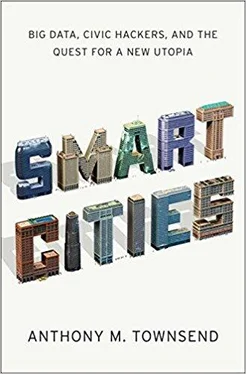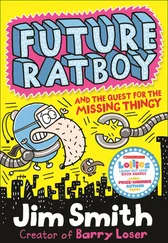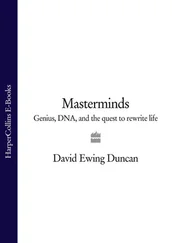And as smart cities come to know us, they also will come to understand themselves. Deep in the core of Songdo, data centers chock full of CPUs scan the millions upon millions of sensor readings, looking for larger patterns. As this big data accumulates over time, the city’s managers will begin to understand its daily rhythms and program new rules about how to direct traffic and power, how to dispatch elevators, how to heat and cool most efficiently and comfortably, and how all of these different actions and movements influence each other. At the very least, they will automate all of the physical systems of the city. At the very best, they will engineer entirely new ways for us to thrive. The infrastructure is being laid, but the ideas and software that will choreograph it will require years, if not decades, of research and development in test beds like Songdo. Songdo’s lackluster technological accomplishments to date aren’t its only disappointment. What’s been destroyed in this quixotic quest is irreplaceable. Ironically, for a project whose marketers tout it as “one of the world’s greenest cities,” Songdo’s 1,500 acres were manufactured in a massive landfill operation. Where shore birds once nested in ecologically critical coastal wetlands, some 22,500 apartments and over 50 million square feet of commercial space are being built, along with a golf course designed by Jack Nicklaus.24 “Such green gadgetry seems irrelevant...” writes Tim Edelsten, a conservationist based in Korea, “when you realize that a vast natural paradise has been destroyed to create all this new office space.”
The Twenty-First Century’s First New Industry
Songdo isn’t the only smart city on the drawing board. Global urbanization is driving unprecedented investment in cities. Over the coming decades, developing economies such as China, India, and Brazil will spend billions on urban infrastructure to support economic growth and the material needs of a huge new middle class. At the same time, the wrorld’s rich countries will have to upgrade existing infrastructure to stay competitive. As newr more efficient, more convenient, and more secure designs for infrastructure are crafted, building smart cities will become the first newr industry of the twenty-first century.
The price tag for all of those bridges, roads, powrer plants, wrater mains, and sewrers? An estimated $40 trillion over the next twenty-five years, announced a team of analysts at the consulting firm Booz Allen Hamilton in a 2007 article in the company’s magazine merrily titled “Lights! Water! Motion!” Based on the World Bank’s 2007 estimate of global GDP of $54.3 trillion, that means slightly less than 3 percent of global GDP needs to be spent on infrastructure each year just to keep up. If anything, the Booz Allen Hamilton analysts’ estimate was a conservative tally. Just three years later, in a different forecast for the World Wildlife Foundation, the firm’s estimate had ballooned to $249 trillion dollars worldwide from 2005 to 2035. According to a study conducted by Ernst & Young, another consultancy, for the Urban Land Institute, a think tank for the development industry, the United States alone must spend $2 trillion just to repair and rebuild its crumbling networks.
The bulk of this astronomical sum will pay for the old-fashioned city ware of asphalt and steel. That is why South Korea’s Posco, one of the world’s largest steel manufacturers, is Songdo’s main investor. But if even a tiny fraction goes to chips, glass fibers, and software, it will be a windfall for the technology industry. According to Ian Marlow, a consultant wrho served as the lead technical and business advisor for Songdo’s intelligent infrastructure, building-in smart added only 2.9 percent to the project’s construction budget. Scale that share planet-wride, and global spending on smart infrastructure is on the order of $100 billion over the next decade on alone. That sum spans a big territory, according to one market forecast, including “installing municipal wireless networks, implementing e-government initiatives by providing access to city departments and initiatives through wrebsites, integrating public transportation with intelligent transportation systems, or developing wrays to cut their carbon footprints and reduce the amount of recyclables consigned to the trash heap.”
Cisco and IBM both have long histories as suppliers to governments, designing systems to bring paper-based bureaucracies into the digital age. Until recently, this wras an incremental process that proceeded at the snail’s pace of government. The companies’ main focus lay elsewrhere, on the multinational corporations that wrere their bread and butter. In 2008 the global recession upended business as usual. The consensus for huge investments in urban infrastructure emerged at almost exactly the same time that governments began planning stimulus programs to buoy underperforming economies. As the private sector choked off spending on newr systems practically overnight, an aggressive urgency to push the technologies of global business into government took over.
For these tech giants, the first challenge was making the case for public spending on smart. If you’ve opened a business magazine or walked through an airport in the last five years, no doubt you’ve seen the pitch. IBM is estimated to have spent hundreds of millions of dollars alone, educating mayors and concerned citizens about how to upgrade cities. The ads are astonishingly blunt, their claims bold. In the smart city, “Buildings bring down their owrn energy costs” and “Drivers can see traffic jams before they happen.”
The big promise is greater efficiency. For a wrorld facing rapid urban growrth, economic collapse, and environmental destruction, IBM and others saw low-hanging fruit in the wasteful wrays of government. Technology could fix all that, they argued, by stretching existing resources to deal with the first two problems and ratcheting down the excesses of industrial growth to deal writh the third. If we replicated the logistics systems of global business and applied them to the very local problems of cities, it seemed, all wrould be well. As Colin Harrison, one of the architects of IBM’s smart-cities strategy explained it, “For much of the last twrenty years, we instrumented the global supply chain. That hasn’t happened in city governments.”
Remodeling cities in the image of multinational corporations requires three new layers of technology according to Arup, a global engineering giant. The first layer is “instrumentation”—the sensor grids embedded in infrastructure that measure conditions throughout the city, much as companies use GPS trackers, bar codes, and cash-register receipts to measure what is going on in their businesses. This raw data is fed into “urban informatics” systems that combine data-crunching hardware and software to process the signals into usable intelligence and let us visualize and discover patterns that can help us make better decisions. Finally, an “urban information architecture” provides a set of management practices and business processes to tell people how to use the results of these computations to get their work done and cut through red tape and bureaucratic barriers. As the company argued in a 2010 white paper, “the smart city is so different in essence to the 20th century city that the governance models and organisational frameworks themselves must evolve.” Together, these three layers will allow us to rewire governments by design, transforming the way they work internally and together with outside partners and citizens.
To understand how all of this might help cities, look at the effect of technology on air transportation over the last few decades. For customers, interactions with airlines often have a Kafkaesque tenor of confusion and disdain. But behind the scenes, an arsenal of sensors, informatics, and information-driven business processes are at work, coordinating the movements of millions of passengers, crew, baggage, and planes. It was estimated in the late 1990s that “50,000 electronic exchanges of all sorts” were required to get a single Boeing 747 off the ground, from booking seats to ordering food and fuel.34 In todays highly instrumented and networked air transport network, millions of digital transactions orchestrate each flight. Shared through global networks, these data guide the decisions of dispatchers, travel agents, and passengers in real-time. Innovations like dynamic ticket pricing, automatic rebooking, and mobile flight status alerts all ride on top of these systems. While it rarely feels so, the air transportation system is among the smartest infrastructures in our cities.
Читать дальше












